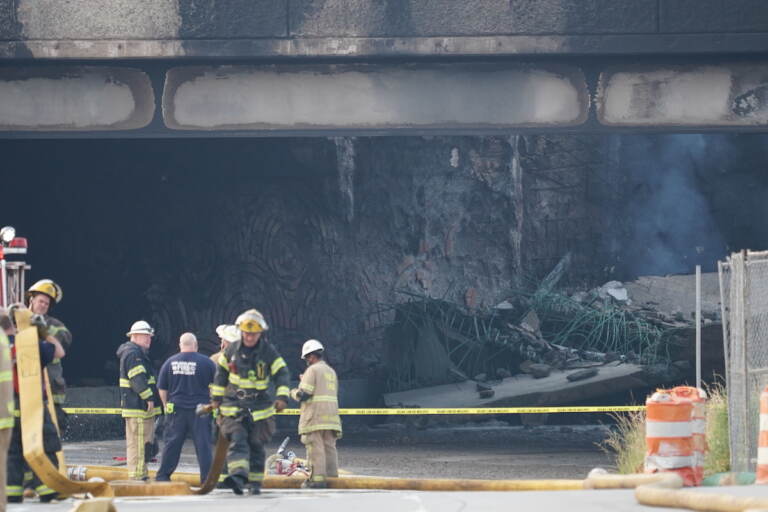PHILADELPHIA, Pa. — According to a new National Transportation Safety Board report, an open cover on a gas tank may have caused the fire that led to the I-95 bridge collapse in Philadelphia.
On June 11, 2023 a truck hauling gasoline crashed into the I-95 overpass and overturned causing a fire and explosion that killed the driver and closed the bridge for several weeks.
According to the NTSB, the fire “most likely originated when gasoline escaped from an open 16-inch manhole … of the trailer as it overturned, and the 2,499 gallons of gasoline/ethanol mixture contained in the compartment began to spill out of the tank and ignite.”
Video evidence obtained by investigators shows the 16-inch “manhole” was open when driver Nathan Moody arrived at the Buckeye Terminal in Wilmington, Del. to refill the tank. The video shows the cover was not properly secured when he drove away to deliver it to a Wawa on Oxford Avenue in Northeast Philadelphia, about 42 miles away.
A “origin and cause” report by the Bureau of Alcohol, Tobacco, Firearms and Explosives (ATF) was issued in September 2023 but was not made public until June 12, 2024. It was included in a set of investigative materials released by the NTSB. The final report is expected to be released in about a year.
A NTSB “human performance” report said the truck rolled over as it negotiated an off-ramp at what appeared in surveillance video from a nearby building to be a high rate of speed.
According to an ATF report it is also possible the aluminum tank ruptured, or vapor recovery elements were damaged, releasing gasoline or vapors, or that the vehicle’s diesel gas tanks ruptured, or a combination of factors.
An NTSB interview with Philadelphia Battalion Chief Theodore Quedenfeld said that early on, firefighters faced “a lot of fire coming out of the storm sewers from the runoff” and that eventually multiple manhole covers from storm sewers became projectiles, flying into the air from the pressure of exploding gasoline.
At one point, firefighters had to shut down their lines because they could not say for sure whether any of the storm sewers were feeding branches that would go toward a water treatment plant.
According to Quedenfeld, there were “dozens, dozens” of explosions.
“It seemed like you would get an explosion and then it would kind of snuff itself out, but the heat would, you know, cause it to reignite as soon as it got a little oxygen,” Quedenfeld told the NTSB.
Philadelphia Fire Capt. Cary Boyd told the NTSB when his team first arrived on the scene “every square foot of that underpass was nothing but flame.”
Later, Boyd said, “the manhole covers were popping and they were big manholes, they’re not the little ones. So, there was a tremendous amount of pressure there.”
The NTSB documents also included a two-page policy issued in 2022 by trucking firm Penn Tank Lines Inc. of Chester Springs, Pa., that mandated pre-trip inspections of tanker manhole covers by truck drivers. That policy described the manhole covers as devices that will form a seal in case of a vehicle rollover and noted an incident a year earlier in which a cover had been left unsecured, “allowing leakage and causing an environmental spill.”
The section of I-95 carried about 160,000 vehicles daily before the crash.
A permanent bridge opened to traffic in November 2023 and the highway returned to normal operations in May 2024.







